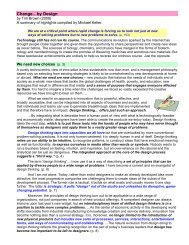A-Teachers-Guide-to-the-Intel-Galileo-Final
A-Teachers-Guide-to-the-Intel-Galileo-Final
A-Teachers-Guide-to-the-Intel-Galileo-Final
Create successful ePaper yourself
Turn your PDF publications into a flip-book with our unique Google optimized e-Paper software.
A TEACHER’S GUIDE TO THE INTEL® GALILEO | 18Beginning with ArduinoBasic Electric CircuitsOverviewIn this activity, students will connect up <strong>the</strong> <strong>Intel</strong>® <strong>Galileo</strong> <strong>to</strong> a simple circuit and make an LEDblink using Arduino code.Materials»»LED»»Breadboard»»<strong>Intel</strong>® <strong>Galileo</strong> board»»<strong>Intel</strong>® <strong>Galileo</strong> software»»100 Ω Resis<strong>to</strong>rResourceshttp://www.scootle.edu.au/ec/viewing/L3059/index.htmlhttp://www.australiancurriculum.edu.au/Elements/ACSSU097http://www.youtube.com/watch?v=MBRTR2dlwvA&cc=1http://www.teachingideas.co.uk/science/contents_circuits.htmhttp://www.scootle.edu.au/ec/p/accessing_scootleThe Blink ExampleWiring InstructionsLEDs have a negative and a positive lead and current only flows one way. The convention is that<strong>the</strong> shorter lead is <strong>the</strong> negative lead while <strong>the</strong> longer lead is <strong>the</strong> positive lead.Connect <strong>the</strong> negative (shorter) lead of <strong>the</strong> LED <strong>to</strong> a resis<strong>to</strong>r by twisting <strong>the</strong>m <strong>to</strong>ge<strong>the</strong>r andconnect <strong>the</strong> o<strong>the</strong>r end of <strong>the</strong> resis<strong>to</strong>r <strong>to</strong> GND next <strong>to</strong> Pin 13.Connect <strong>the</strong> positive (longer) lead of <strong>the</strong> LED <strong>to</strong> Pin 13. Make sure <strong>the</strong>re is no <strong>to</strong>uching between<strong>the</strong> resis<strong>to</strong>r and <strong>the</strong> positive lead of <strong>the</strong> LED.



